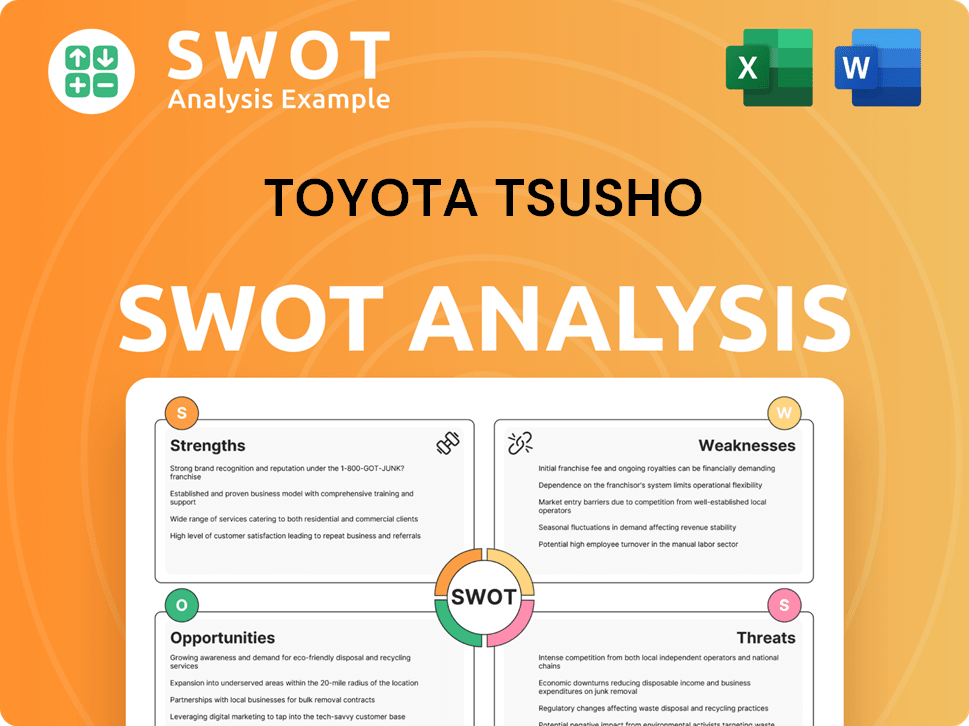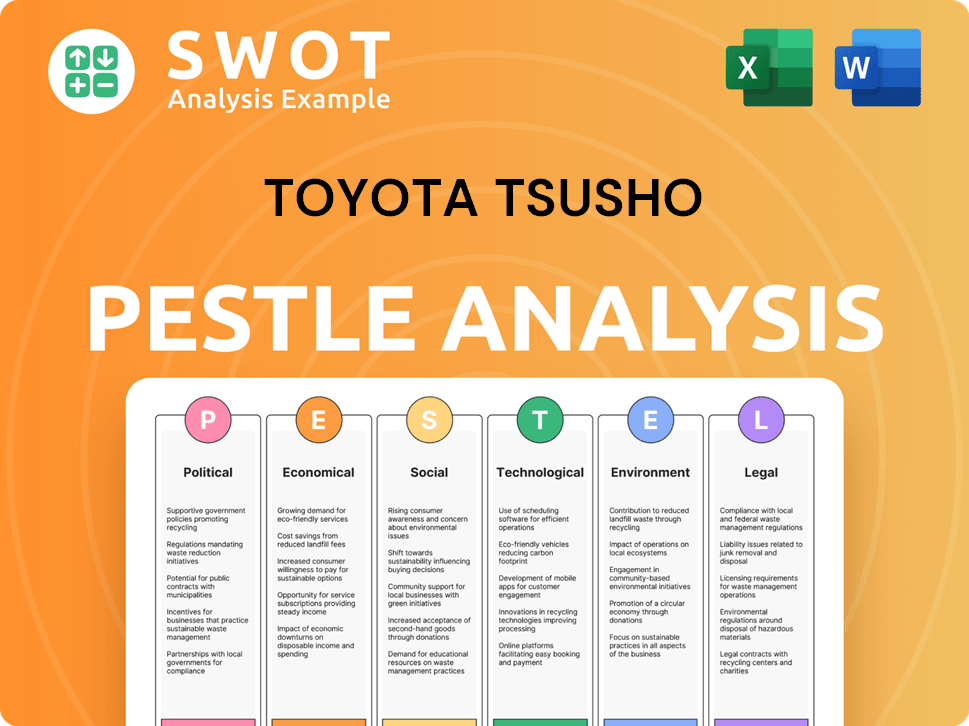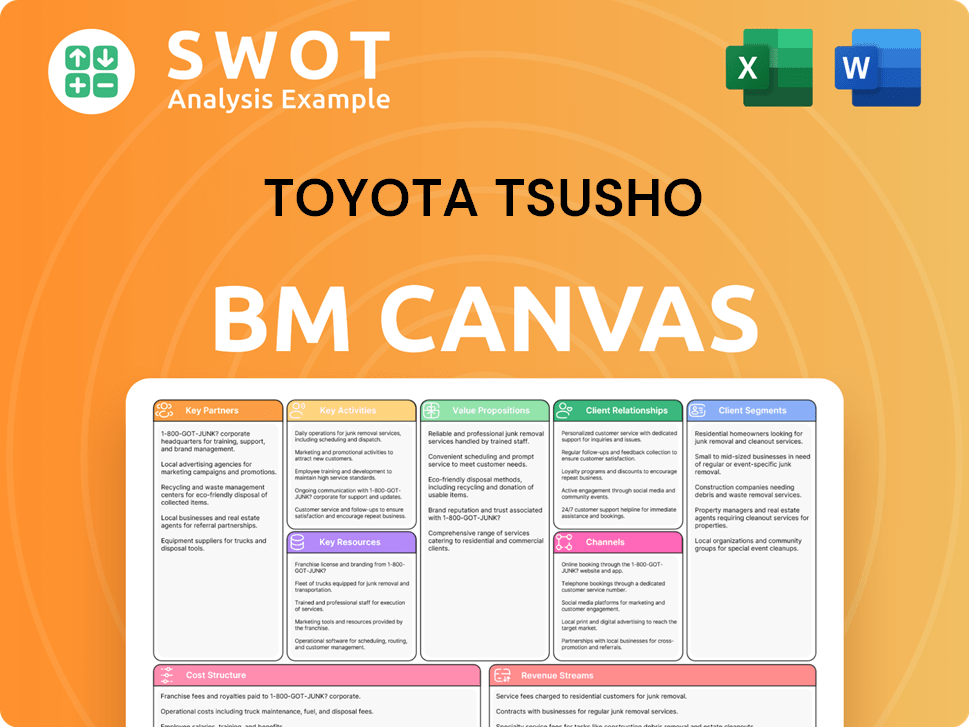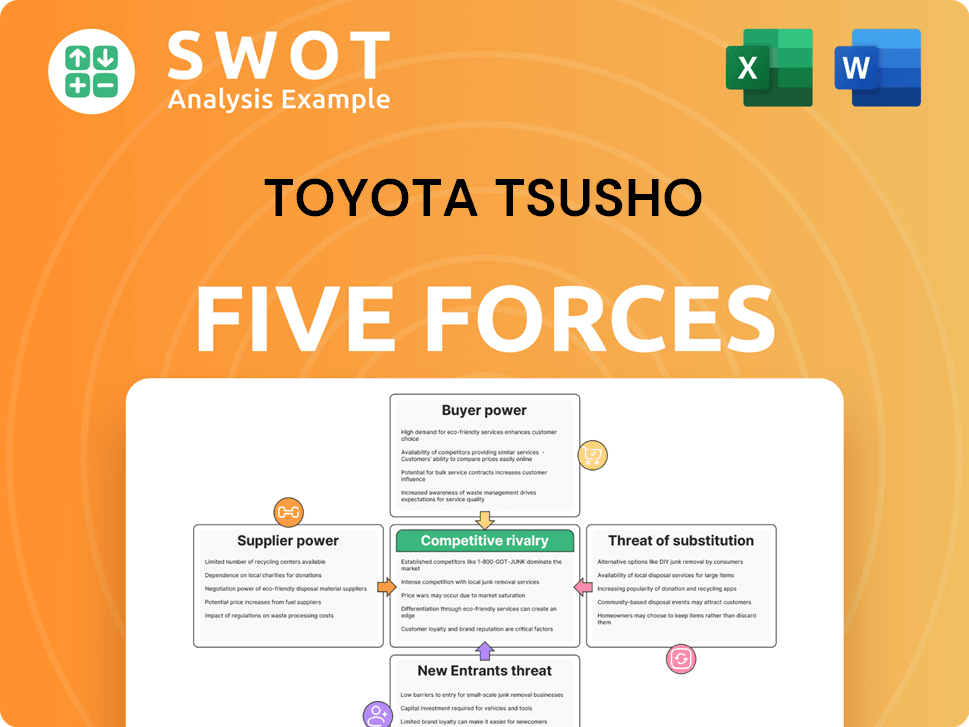Toyota Tsusho Bundle
Who Does Toyota Tsusho Serve?
Ever wondered who fuels the global engine of Toyota Tsusho? From its roots supporting Toyota's automotive ambitions, this global trading giant has evolved into a multifaceted enterprise. Understanding the Toyota Tsusho SWOT Analysis is key to grasping its strategic direction. This exploration dives deep into the customer demographics Toyota Tsusho and target market Toyota Tsusho, offering insights into its diverse customer base.

Delving into Toyota Tsusho's customer profile reveals a complex web of industries and geographies. Toyota Tsusho business spans metals, energy, and food, each with distinct Toyota Tsusho target audience profiles. This analysis provides a comprehensive Toyota Tsusho market analysis, uncovering the strategies behind its global success and how it adapts to evolving customer needs, from the automotive sector to emerging markets in Africa and beyond. Understanding Toyota Tsusho's target market by industry is crucial for anyone looking to gain insights into this global player.
Who Are Toyota Tsusho’s Main Customers?
Understanding the customer demographics of Toyota Tsusho is crucial for grasping its business model. The company primarily operates in a business-to-business (B2B) environment, focusing on providing services and products to other businesses rather than directly to consumers. This strategic focus shapes its target market and customer profile.
Toyota Tsusho's customer base is diverse, spanning multiple sectors. This includes manufacturers of machinery, textile industries, and semiconductor companies, along with firms in the chemical, plastic, beverage, energy, automotive, electronics, and food and agriculture sectors. This broad reach reflects the company's role as a global trading house, facilitating transactions and providing services across various industries. A deeper look into the Brief History of Toyota Tsusho provides more context on its evolution and market position.
Within its Mobility segment, Toyota Tsusho supports the automobile business of Toyota Motor and other Toyota Group companies. This involves exporting passenger cars, commercial vehicles, trucks, buses, and spare parts. The Metals segment serves clients in steel processing and nonferrous metal manufacturing. The Chemicals & Electronics segment caters to industries with automotive components, semiconductors, and electronic components. The Africa segment is a significant growth area, with automobile sales contributing 21% of net profit as of FY March 2024.
Toyota Tsusho's main customers are other businesses (B2B) across various sectors. These include manufacturers, suppliers, and companies in the automotive, metals, chemicals, and electronics industries. The company's focus on long-term partnerships suggests a target demographic of established businesses seeking reliable supply chains and integrated solutions.
Toyota Tsusho segments its customers by industry and geographic location. Key segments include Mobility, Metals, Chemicals & Electronics, and the Africa segment. This segmentation allows the company to tailor its services and products to meet the specific needs of each market and customer group. The company is investing 1 trillion yen in renewable energy over the next decade, with a focus on Africa and India.
Toyota Tsusho's target market includes the automotive sector, metals industry, chemical and electronics industries, and the food and agriculture sectors. The company's expansion into renewable energy and the circular economy indicates a strategic shift towards sustainable and growth-oriented industries. The Africa segment also includes healthcare, consumer finance, retail businesses, electricity infrastructure, agriculture, and ICT.
Specific demographic data, such as age, gender, or income levels, for Toyota Tsusho's B2B clients are not publicly available. However, the company's focus is on established businesses seeking reliable supply chains and integrated solutions. The company's strategic focus is on emerging markets and growth areas, such as renewable energy, driven by global trends and market research.
Toyota Tsusho's customer base consists primarily of established businesses across various industries. The company focuses on long-term partnerships, indicating a target demographic of reliable businesses seeking integrated solutions. The company's strategic focus on emerging markets and growth areas, such as renewable energy, is driven by global trends and market research.
- Established businesses seeking reliable supply chains.
- Businesses in the automotive, metals, chemicals, and electronics industries.
- Companies in emerging markets and growth areas, such as renewable energy.
- Businesses seeking integrated solutions and long-term partnerships.
Toyota Tsusho SWOT Analysis
- Complete SWOT Breakdown
- Fully Customizable
- Editable in Excel & Word
- Professional Formatting
- Investor-Ready Format

What Do Toyota Tsusho’s Customers Want?
Understanding customer needs and preferences is crucial for the success of any business, and Toyota Tsusho is no exception. The company's diverse operations across various sectors require a deep understanding of its varied customer base. This includes knowing their needs, motivations, and preferences to tailor offerings and services effectively.
For its business-to-business (B2B) clients, Toyota Tsusho focuses on providing stable supply chains and high-quality industrial materials. They also offer specialized machinery and equipment. This focus on long-term partnerships and customized solutions is evident in its high rate of repeat customers. This approach is critical to meeting the specific demands of its diverse portfolio, including automotive, machinery, and chemicals.
Toyota Tsusho's commitment to understanding its customers is further demonstrated through its market research efforts. In 2022, the company invested approximately ¥10 billion in market research. This investment helps them stay ahead of emerging trends, such as electric vehicles and renewable energy. This allows them to adapt their offerings and marketing strategies effectively.
Toyota Tsusho's B2B clients prioritize stable supply chains and high-quality industrial materials. They also require specialized machinery and equipment. This focus on core needs is key to building strong, lasting relationships.
In the automotive sector, customers seek reliable vehicle parts and logistics services. Toyota Tsusho addresses these needs through its Global Production Parts & Logistics segment. This ensures timely delivery and quality parts.
Clients in the Machinery, Energy & Project segment need manufacturing and distribution equipment. They also require parts, tools, construction machinery, and essential energy resources. Toyota Tsusho provides comprehensive solutions to meet these diverse needs.
Toyota Tsusho emphasizes tailored customer service to meet specific demands. They build long-term partnerships, recognizing that a diverse portfolio requires customized solutions. This approach has resulted in a high percentage of repeat business.
Businesses increasingly prioritize environmental impact, and Toyota Tsusho invests in renewable energy and sustainable solutions. This includes investments in battery and resource recycling sectors. This helps enhance vehicle battery production and raw material procurement.
Toyota Tsusho leverages market research to understand emerging trends, such as electric vehicles and renewable energy. In 2022, they invested approximately ¥10 billion in market research. This allows them to adapt their offerings and marketing strategies.
Toyota Tsusho's customer-centric approach is evident in its strategic initiatives. For instance, in Africa, the company produces and sells sanitary napkins in Kenya. This demonstrates a response to unmet social needs. It also shows a focus on contributing to local communities. For a deeper dive into how the company approaches its overall strategy, consider reading about the Marketing Strategy of Toyota Tsusho.
Toyota Tsusho's customer base has diverse needs. They range from stable supply chains to sustainable solutions. The company focuses on building long-term partnerships and providing tailored services. This approach has led to a high rate of repeat business, with approximately 70% of revenue coming from repeat customers in FY2022.
- Stable and efficient supply chains.
- High-quality industrial raw materials.
- Specialized machinery and equipment.
- Reliable vehicle parts and logistics services.
- Manufacturing and distribution equipment.
- Essential energy resources.
Toyota Tsusho PESTLE Analysis
- Covers All 6 PESTLE Categories
- No Research Needed – Save Hours of Work
- Built by Experts, Trusted by Consultants
- Instant Download, Ready to Use
- 100% Editable, Fully Customizable

Where does Toyota Tsusho operate?
Toyota Tsusho Corporation maintains a substantial global presence, operating through over 150 offices and 900 subsidiaries and affiliates worldwide. This extensive network allows the company to engage with diverse customer demographics and cater to varied market needs. The company's geographical market presence is broad, encompassing North America, Central and South America, Europe, CIS Countries, the Middle East, East Asia, Asia, and Oceania.
A significant portion of Toyota Tsusho's revenue is generated overseas, with 72% of its overseas revenue proportion reported for FY March 2024. This underscores the importance of its international operations and its ability to adapt to different regional markets. The company's strategic focus on global expansion and localized offerings is critical for its long-term growth and success in a competitive global market. Understanding the Growth Strategy of Toyota Tsusho provides further insights into their market approach.
Africa is a particularly strong market for Toyota Tsusho, where it has a leading presence in the automotive business and accounts for 21% of the company's net profit as of FY March 2024. The company's commitment to developing markets in Africa, coupled with its investments in renewable energy and other sectors, highlights its long-term perspective and commitment to sustainable growth across diverse customer demographics.
Recent expansions in Africa include the start of semi knock-down production of Hilux pickup trucks and Fortuner SUVs in Cambodia in May 2024. This expansion supports the automotive sector, a key part of Toyota Tsusho's business in Africa.
The expansion of the Gulf of Suez Wind Farm II in Egypt to 654 MW, making it the largest wind farm in Africa, with commercial operation for the expanded capacity scheduled to begin in August 2025. This shows the company's commitment to the renewable energy sector.
In January 2025, Toyota Tsusho, in partnership with Unicharm Corporation, commenced production and sales of sanitary napkins in Kenya. This diversification targets the local consumer market.
In North America, Toyota Tsusho America, Inc. invested in a 125-megawatt solar power plant in Texas, with solar energy generation slated to begin in summer 2025. This project supports carbon neutrality goals.
In Europe, Toyota Tsusho Europe SA established a new joint venture, 'SympH2ony,' in July 2024, to offer solutions for the transition to hydrogen-powered vehicle fleets. This venture addresses the growing demand for sustainable transport solutions.
The company also plans to expand into offshore wind in Japan and Europe. These regional efforts demonstrate Toyota Tsusho's strategy of localizing its offerings and partnerships to succeed in diverse markets.
Toyota Tsusho Business Model Canvas
- Complete 9-Block Business Model Canvas
- Effortlessly Communicate Your Business Strategy
- Investor-Ready BMC Format
- 100% Editable and Customizable
- Clear and Structured Layout

How Does Toyota Tsusho Win & Keep Customers?
To understand the customer acquisition and retention strategies of Toyota Tsusho, it's essential to examine their approach to building and maintaining customer relationships. The company focuses on long-term partnerships, providing tailored services to a diverse customer base that includes both large corporations and smaller businesses. This strategy has proven effective, with a significant portion of revenue coming from repeat customers, demonstrating strong customer loyalty.
Toyota Tsusho's commitment to customer satisfaction is further evident in its active engagement in trade shows and industry events, and its use of digital transformation and data-driven marketing. This approach helps streamline business processes and improve supply chain management. By prioritizing direct engagement and solution-oriented sales tactics, the company aims to meet the specific needs of its clients. The company's approach to customer relationship management is also key to its success.
The company's customer acquisition and retention efforts are supported by advanced Customer Relationship Management (CRM) systems. These systems help manage customer interactions and sales data, enabling personalized services and targeted campaigns. Furthermore, Toyota Tsusho adapts to evolving customer needs, such as by investing in green infrastructure and circular economy initiatives, which contributes to customer loyalty by aligning with their sustainability goals. These efforts are designed to enhance customer satisfaction and foster long-term relationships.
Toyota Tsusho prioritizes long-term partnerships with its clients, which include major global corporations and smaller businesses. This relationship-driven approach is a core element of their strategy. These relationships are crucial for customer retention.
To acquire new customers and strengthen existing relationships, Toyota Tsusho actively participates in trade shows and industry events. In 2023, the company attended over 50 major global trade exhibitions. This contributes significantly to their sales efforts.
Toyota Tsusho utilizes digital transformation and data-driven marketing to streamline business processes and enhance supply chain management. This helps in providing tailored solutions. This approach improves customer service.
Customer data and CRM systems play a vital role in enabling personalized services and targeted campaigns. Toyota Tsusho uses advanced CRM systems to manage customer interactions and sales data. This helps in providing tailored solutions.
Toyota Tsusho's customer acquisition and retention strategies are deeply intertwined with its understanding of its target market. To gain further insights into their competitive landscape, you can refer to the Competitors Landscape of Toyota Tsusho. The company's focus on long-term partnerships, participation in industry events, and the use of digital tools highlight its commitment to building and maintaining strong customer relationships within its target market. By understanding the needs of its target audience, Toyota Tsusho can tailor its services and strategies to ensure customer satisfaction and loyalty. In FY 2022, approximately 70% of the company's revenue came from repeat customers, showcasing the effectiveness of these strategies. The company's proactive engagement in new ventures, such as the investment in LOGIQUEST INCORPORATED for last-mile delivery in October 2024, demonstrates an adaptive strategy to evolving logistics needs and enhances service offerings to its partners.
Toyota Tsusho Porter's Five Forces Analysis
- Covers All 5 Competitive Forces in Detail
- Structured for Consultants, Students, and Founders
- 100% Editable in Microsoft Word & Excel
- Instant Digital Download – Use Immediately
- Compatible with Mac & PC – Fully Unlocked

Related Blogs
- What are Mission Vision & Core Values of Toyota Tsusho Company?
- What is Competitive Landscape of Toyota Tsusho Company?
- What is Growth Strategy and Future Prospects of Toyota Tsusho Company?
- How Does Toyota Tsusho Company Work?
- What is Sales and Marketing Strategy of Toyota Tsusho Company?
- What is Brief History of Toyota Tsusho Company?
- Who Owns Toyota Tsusho Company?
Disclaimer
All information, articles, and product details provided on this website are for general informational and educational purposes only. We do not claim any ownership over, nor do we intend to infringe upon, any trademarks, copyrights, logos, brand names, or other intellectual property mentioned or depicted on this site. Such intellectual property remains the property of its respective owners, and any references here are made solely for identification or informational purposes, without implying any affiliation, endorsement, or partnership.
We make no representations or warranties, express or implied, regarding the accuracy, completeness, or suitability of any content or products presented. Nothing on this website should be construed as legal, tax, investment, financial, medical, or other professional advice. In addition, no part of this site—including articles or product references—constitutes a solicitation, recommendation, endorsement, advertisement, or offer to buy or sell any securities, franchises, or other financial instruments, particularly in jurisdictions where such activity would be unlawful.
All content is of a general nature and may not address the specific circumstances of any individual or entity. It is not a substitute for professional advice or services. Any actions you take based on the information provided here are strictly at your own risk. You accept full responsibility for any decisions or outcomes arising from your use of this website and agree to release us from any liability in connection with your use of, or reliance upon, the content or products found herein.